 Taking on a new PPC account can be daunting when you can see that there’s lots to be improved on. It’s great that you know you can make a difference and improve the account, but you might find yourself wondering where to start!
Taking on a new PPC account can be daunting when you can see that there’s lots to be improved on. It’s great that you know you can make a difference and improve the account, but you might find yourself wondering where to start!
A PPC audit is a great way to start any PPC project, as it will help you clearly identify the areas that need improving, so you can prioritise them and work through them in manageable chunks.
If you’re at the early stages of selling PPC into your client, a basic audit could be the key to getting them on board as you can clearly show them the areas that you can improve for them and demonstrate the benefit that would have.
When to do an AdWords PPC audit
Avoid running an audit straight after you have made lots of changes to an account, as you may find you have skewed data. My advice is to perform an audit when you start a project, and then do it again a couple of months after you have been working on it. Also make sure that when you conduct the audit, you have selected a date range that provides significant enough data. I use at least the last three or four months, but be careful to consider seasonality too as this may skew your analysis.
How to start a PPC audit
A great place to start is with a free tool such as Wordstream’s AdWords Performance Grader, as it can offer insight and compare your account to other AdWords accounts with the same level of spend in your vertical, which is something that is completely unique.
The tool will give you an overview of your performance in terms of wasted spend (negative keywords), Quality Score, Impression Share, Click through Rate, Long Tail keywords, ad text, landing pages, mobile targeting and other best practices.
The benefit of using this tool as a starting point is that it provides all this data within the context of comparing your account to other accounts in the same vertical as you, with a similar ad spend. This means that if you are a small local book retailer, you won’t find your account compared with the likes of Waterstones, who are likely to have a much larger ad spend. You gain an indication of which areas you need to improve in the account, alongside what the industry average performance is.
Below I’ve used the tool to quickly identify the basic areas that may need improvement on an account running search campaigns, and then I’ve provided my own account audit checklist for each area, so that when you run your own site through this tool you can have some tips on how to improve them!
PPC Keyword Audit
Negative Keywords
The Wasted Spend section of the WordStream AdWords PPC Grader Report uses the number of negative keywords added to your account in the last 90 days, to estimate how much money you could be saving by adding more negative keywords. This is a very handy figure to justify the time that has been spent on negative keywords.
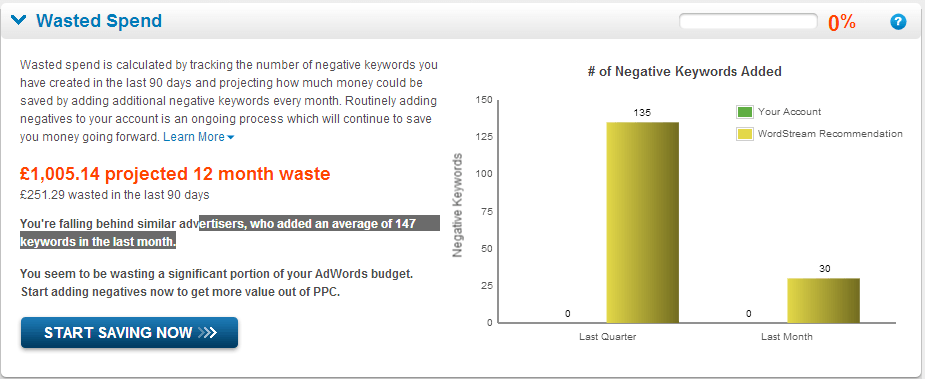
In this example you can see that the account is well below the recommended level of negative keywords and it tells me that I’m falling behind similar advertisers. If you have a similar diagnosis as this account, try:
- Review your Search Query Report over all time and add any negative keywords you find in here
- Review your Search Query Report every week moving forwards, so that you can easily cut out wasted spend in small manageable chunks of optimisation
- Add your negative keywords as one word terms as often as possible, as this will block more searches than phrase or exact match negatives
- Conduct additional negative keyword research, by searching for broadly related terms in the AdWords Keyword Planner, and then reviewing them and adding any irrelevant keywords as negatives
- Add your negative keywords as negative keyword lists in the shared library, so that they can easily be shared across future campaigns
- Add negative keywords at campaign level wherever possible, but also do detailed ad group negative keyword research and add ad group specific negatives at ad group level
Keyword Match Types
Review your account for the keyword match types you are using. Try out both phrase and exact match keywords if they are suitable, and review their performance over time.
The ‘PPC Best Practices’ section of the WordStream report reminds advertisers to use modified broad match keywords, and they couldn’t be more right! If used correctly, Modified Broad Match keywords can really benefit your campaigns.
Use Modified Broad Match keywords instead of standard broad match to gain some more control over your keywords. This works particularly well for terms that people often miss-spell, such as holiday destinations.
Learn more about Modified Broad Match here.
Keyword Expansion
Adding new keywords to the account should be done regularly, and not just at the start of a project.
Review the Search Query Report and add any terms that have converted at a suitable cost as keywords in their own ad groups.
Longtail Keywords
The Long-Tail Keyword optimisation part of the WordStream report reports the percentage of longtail keywords in your account, and identifies the opportunity for adding more longtail terms, which can lower your CPC and often convert better.
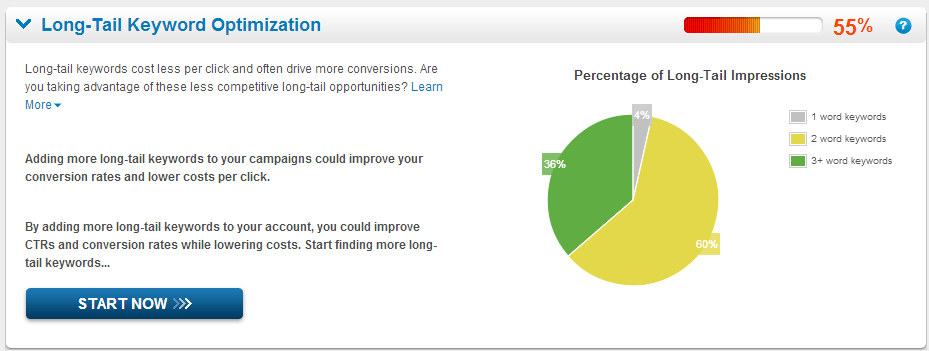
Some tips for long-tail keyword optimisation are:
- Get longtail keyword ideas using:
-
- Your Search Query report
- Your Google Webmaster Tools keywords data
- Independent tools such as Ubersuggest
- Typing your base term into Google followed by a space, and seeing what suggestions Google provide you with – if they are relevant add them as new longtail keywords
-
- If your longtail keywords have a status of ‘Low Search Volume’ when you add them to AdWords, try adding them as Modified Broad Match and they will probably become eligible again
Keyword Matching Options
You can choose to allow Google to include plurals, spellings and close variants within your phrase and exact match keywords.
If you have modified broad match, or broad match keywords in your campaigns anyway, this probably isn’t necessary, but it may help you discover new terms that you aren’t yet bidding on when you review your keyword report.
If you have a very well structured account with separate ad groups for singulars and plurals keywords, I would recommend against this setting, as it may cause the singular ad group to show for the plural and visa-versa.
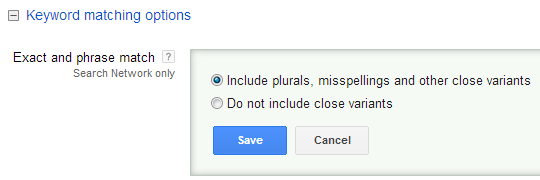
Keyword Performance Review
Keep an eye on the performance of all your keywords and make the following checks (but bear in mind some of the revenue and cost focused checks are more applicable to ecommerce websites)
- Ensure all keywords are eligible and not under review (filter by keyword status within the keywords tab for the whole account or selected campaigns)
- Review keywords with a low average position – it’s not always the most cost effective thing to have all keywords in top positions, but if you want to increase their positions you could increase their bids and try to increase the relevance of their ads within the ad group for that keyword
- Review keywords with a high CPC and consider whether they generate enough revenue to justify the CPC
- Review keywords with a high cost (spending a large portion of your daily budget) and consider this alongside their conversion value – do they justify taking up that much of the ad spend? If you want to control the spend in more detail separate them into their own campaign so they have a dedicated daily spend just for that keyword
- Review the average Cost per Conversion in relation to the Conversion Value over Cost metric to see if the conversions are generating enough value to warrant the spend they have
- Review the total conversion value in relation to the total cost to see if overall the campaigns provide greater revenue than the spend they use
- Review the Conversion Rate, but don’t get too caught up on it as it’s likely to fluctuate, and just because a term has a good conversion rate, it doesn’t mean that the cost it creates is equal to the value it brings in
Structure
Your account structure is a fundamental part of a PPC audit, as getting the structure right means you can target your ads and keywords to the most bespoke level.
Here are some things to check for:
- Are ad groups tightly themed into small groups of keywords?
- Aim to have one keyword per ad group if possible
- Are display and search campaigns in separate campaigns?
- Are significantly different product areas in different campaigns?
- If you are targeting various different locations, have they been split into different location campaigns? (even if you are using bid adjustments – as separate campaigns will help you have more granular control over performance and ad spend)
Bids and Budgets:
The WordStream AdWords Performance Grader Tool has a section on Impression Share, which is closely linked to bidding and budgets:
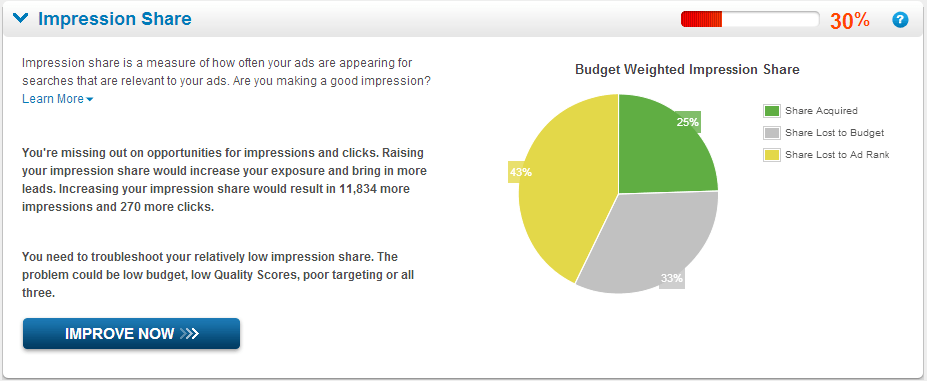
Here you can see that this particular account is missing out on 33% of the impression share they could have, due to the budget.
Lost Impression Share due to Budget
In this instance, you might see a note next to some or all of your campaigns saying they are limited by budget in AdWords. When you click on the notification AdWords will tell you what they recommend increasing your budget to.
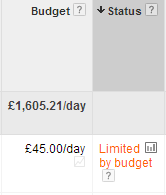 If you find that your ads stop running before the end of the day, or aren’t showing all the time, and you have identified that you are missing out on impression share due to budget, it is likely that Google are spreading out the frequency at which they let your keywords go to auction in order to spread out your daily budget. Increasing your budget in this instance will allow your ads to show more often when they are eligible.
If you find that your ads stop running before the end of the day, or aren’t showing all the time, and you have identified that you are missing out on impression share due to budget, it is likely that Google are spreading out the frequency at which they let your keywords go to auction in order to spread out your daily budget. Increasing your budget in this instance will allow your ads to show more often when they are eligible.
Check if your ads are running out before the end of your schedule by visiting the Dimensions Tab, and selecting ‘View: Hour of day’. If there are no impressions in the later hours of the schedule you may find that you are running out of budget early:

Never increase your budget any more than you can afford, and consider your revenue and conversion value above Google’s budget recommendations.
If you can’t afford to increase your budget, try the following:
- Try moving some budget from campaigns that are not limited by budget, over to the campaigns that are limited by budget
- Ensure the budget you do have is allocated appropriately with a priority on the campaigns that convert best
- Consider using Shared Budgets so that all of your campaigns (or a select group of them) can share one big budget across them and let Google spend your budget across the campaigns according to where the highest search demand lies (keep an eye on conversions if you do this – just because a campaign has lots of search demand, doesn’t mean it will be the best converter)
- Amend your ad scheduling so that your ads are only running at the times they are most profitable for you – this will ensure your budget is only used at key times of the day
Lost Impression Share Due to Rank
If you are losing out on impression share due to rank, it means your ad rank isn’t strong enough to ensure you’re eligible to show as often as you could. It also means that you are paying more per click than you could be if you improve your ad rank.
You can learn more about ad rank here.
To improve your ad rank, try the following:
- Optimise your account for Quality Score (CTR, Relevancy and Landing Page)
- Increase your Max CPC bids slightly
- Ensure ALL relevant ad extensions are enabled and performing well (optimise them if they aren’t)
Google’s First Page Bid Estimates
Filter your keywords in the keywords tab, using the ‘status’ filter, to see if any of them are below Google’s first page bid estimate.
You might not necessarily have to pay this bid, and your ads may still show if your bid is below this recommendation.
If the estimate is much higher than you expected, it might indicate that you have a poor Quality Score as your Quality Score is taken into account within the estimate, as well as the current advertiser competition levels.
I’d recommend bidding above this estimate if you can afford to.
Bid Strategy Settings
If you have enough time to manually manage your bids, or if you use a third party bid management tool, you should select “I’ll manually set my bids for clicks”:
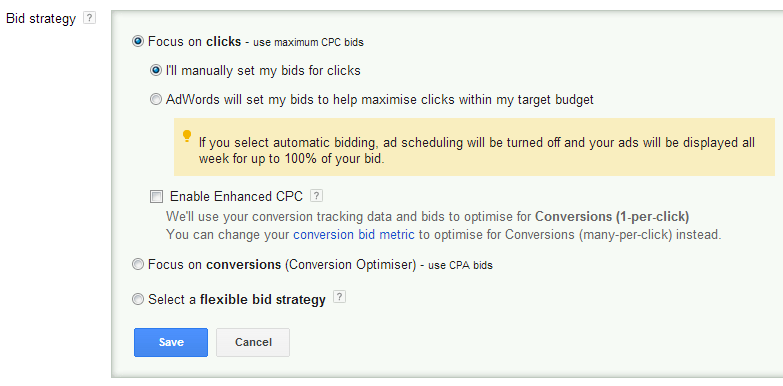
If you’d like to experiment with other bidding options, you can learn more about them here:
- AdWords Enhanced CPC
- AdWords Conversion Optimiser
- AdWords Flexible Bidding Strategies
PPC Ad Audit
The Click through Rate (CTR) section of the WordStream report is great for getting an overview of your whole account CTR. In this example you can see that the account could expect 102 more clicks or one additional conversion per month, by improving the CTR to 3.94% from the current 2.28%.
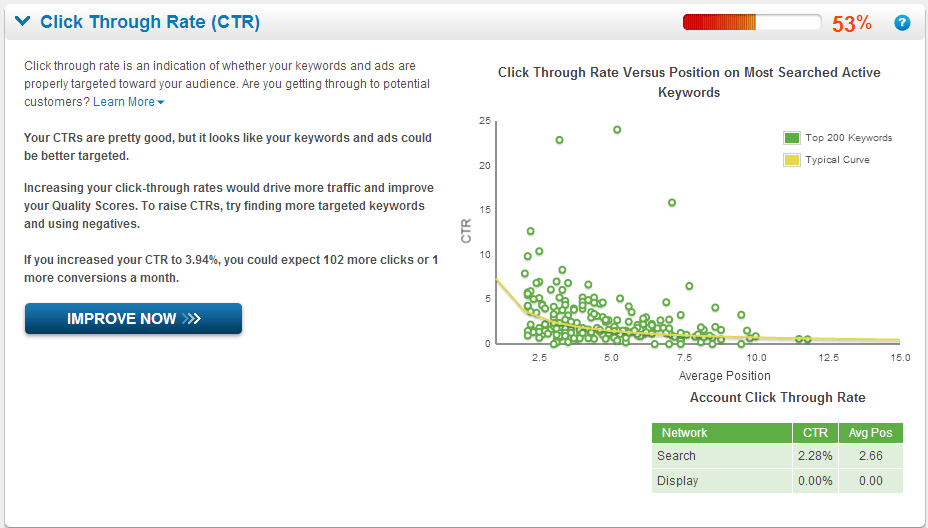
Remember that CTR is affected by your average position and bids, as well as your keyword and ad relevance, so optimise your keywords and ads as well as bids to truly improve CTR.
The Text Ad Optimisation section of the Wordstream report quickly points out whether you have enough text ads per ad group, as well as which of your ads are the top and worst performer, so you can get some ideas for your future ad optimisation:
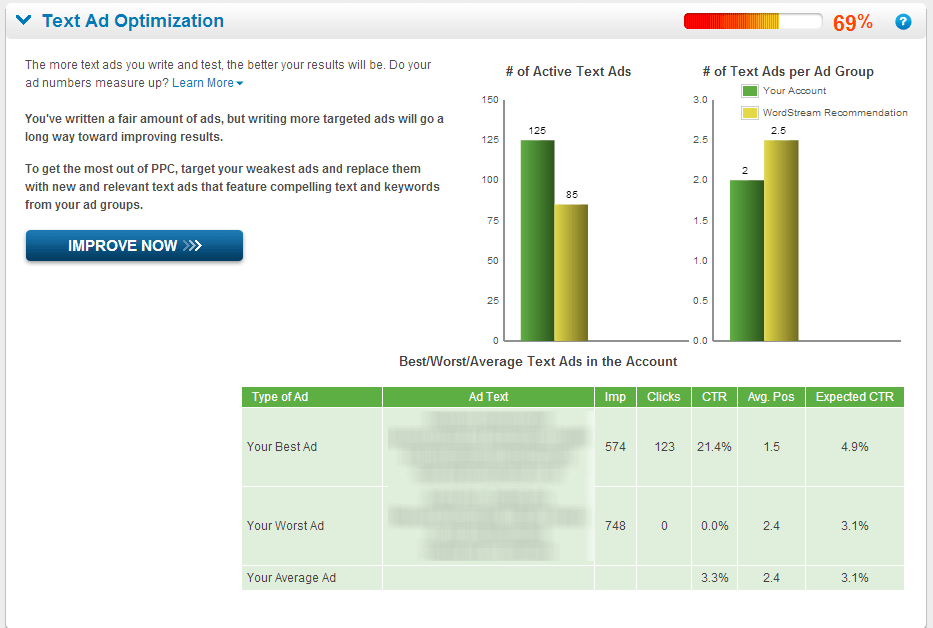
To optimise your ads to improve CTR, try the following:
- Include the keyword in the title of ads, as well as in the display URL
- Use at least two ads per ad group and perform regular split testing
- Ensure none of your ads are under review or disapproved
- If your ads have dates or time relevant offers ensure they are up to date
- Ensure your ads use the correct grammar and are sensitive to the tone of your product – for example don’t use exclamation marks if your product is of a serious or sensitive nature
- Ensure all available ad extensions are enabled and regularly optimised
Ad Delivery Settings
Select ‘Rotate Indefinitely’ to ensure each of your ads gains more equal opportunities to show, so that you can manually split test them:
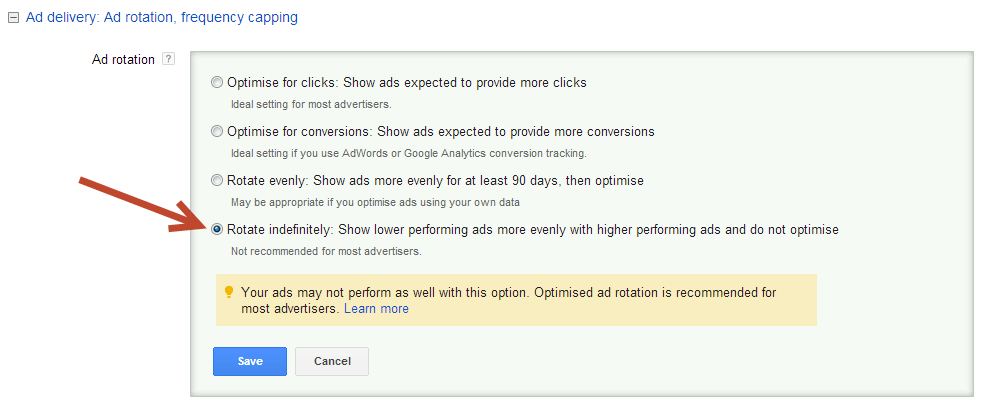
I prefer manually split testing my ads to letting Google select top performers, as I believe Google determines those that are top performers based on too little data meaning they don’t give each ad a fair chance to perform and this might mean strong ads are retired too early on.
Scheduling
- Use the Dimensions tab data to segment campaign performance by time of day, as well as day of the week.
- Use a date period of at least the last 60 days and account for seasonal trends.
- Set bid adjustments based on any trends you spot, such as bidding up when average position is normally low, to try to increase CTR.
- Exclude any time periods or days which always perform poorly.
Location Targeting
Location targeting should be audited on a campaign by campaign basis, making sure that location bid adjustments are in place to counter any low CTR locations at campaign level.
Review data in the Dimensions tab to see location performance, including user locations. You may find some user locations are irrelevant and can be excluded.
Don’t forget location settings in the campaign settings tab too:

Unless your business is the sort of business where someone might be searching for it from a different country, you should select ‘People in my target location’ so that Google only shows ads to those who are geographically within the location you are targeting.
If people might be searching for your business service from a location other than the location that you are targeting, select ‘People in, searching for or viewing pages about my target location’. For example if you are a South African car hire company offering car hire in South Africa, people in the UK might search for and buy your services for when they come on holiday to South Africa. In this instance you want people outside of South Africa to see your ads if they have a relevant search term that includes your location.
Device Targeting
The Mobile Advertising section of the WordStream report outlines how much of your ad spend goes on mobile devices compared to desktop.
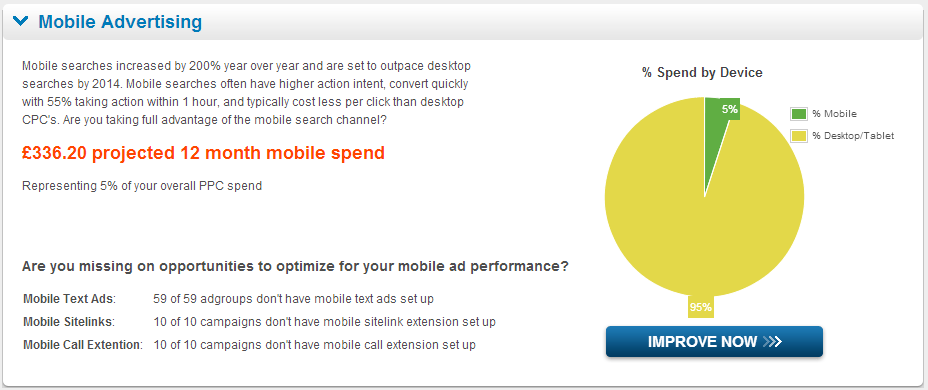
Mobile is increasingly important, so if your site works well on mobile and the user can easily complete a conversion with a smooth user experience on their mobile device, then you should try bidding on mobile devices within your PPC account with the following tips:
- Set mobile bid adjustments at ad group level rather than keyword level, so you have more granular control over them
- If an ad group doesn’t perform well on mobile, set your bid adjustment to -100% to opt out of mobile advertising
- Review your average position on mobile devices using the dimensions tab data, and aim for a position of 2 or above, and ideally position one, as most mobile devices only have space for one or two ads on the screen
- If your ad has a poor position on mobile, try making your bid higher using bid adjustments, as well as increasing ad relevance and CTR as with normal desktop ads
- Create mobile specific ads (choose ‘mobile’ in the drop down section next to your ad in AdWords Editor)
- Create mobile specific sitelinks that contain links to pages of your site that would be most useful to mobile users, such as ‘directions’ and ‘contact us’
- Create specific mobile call extensions
Conversion Tracking
Conversion tracking is essential to know if your AdWords account is delivering users who are completing the aim of your website.
- Is the site an ecommerce website? If so, check if Ecommerce Tracking is enabled in Google Analytics and import ecommerce tracking into AdWords (it is done in the same way that you import normal goals, but the goal will be automatically named ‘Transactions’
- Check that any email addresses on the site have event tracking set up for them, so you can track clicks on them
- Check any phone numbers have mobile call tracking enabled, this will track when someone visits your site via a mobile device and calls you directly by clicking this number on your website via their mobile device
- Have conversions been tracked in the last 30 days? If not, test the conversion
- Review all goals in Google Analytics to see if any of them should be imported as conversions in AdWords
- Check that any goals imported from Google Analytics aren’t also being tracked using AdWords conversion tracking code and doubling up your figures
- Review time on site and bounce rate once you have linked AdWords and Analytics
Quality Score
The Quality Score section of the AdWords Performance Grader report from WordStream gives you a nice quick insight into your impression weighted average Quality Score for the account. It also estimates how much money could be saved by improving Quality Score, which is very handy if you need to make a case for optimising for Quality Score.
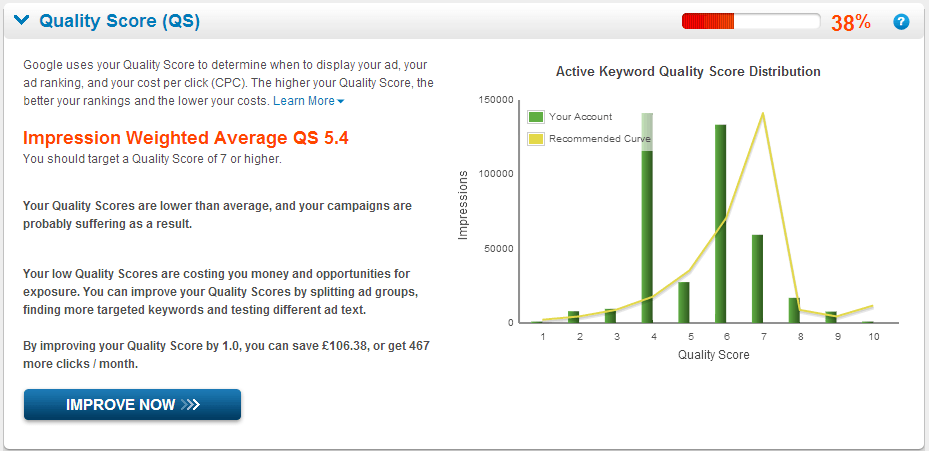
When auditing your Quality Score, consider the following:
- Keyword level Quality Score
- Account level Quality Score
- Ad level Quality Score
- Device Quality Score
- Landing page quality
You can learn more about different Quality Score types and how to optimise them here.
Track your efforts at improving different levels of Quality Score using the following AdWords Scripts:
- Script for Account, Campaign & Ad Group level via Free AdWords Scripts.com
- Script for Keyword Level via PPC Epiphany
If you look at your account manually for Quality Score, rather than using scripts, always use a weighted impression Quality Score, so you can be sure to focus on the areas that will have the most impact. You can learn about impression weighted Quality Score here.
Landing Page Optimisation
The Landing Page Optimisation section of the Wordstream report points out whether you have enough variety of landing pages within your account, compared to other advertisers within your monthly spend range. Having a wide variety of landing pages suggests that you have optimised your landing pages and they are going to the relevant product or service pages within your site, rather than just the Home page for example. It also indicates that you might be using bespoke PPC landing pages, which can help with your Quality Score and increase conversions.
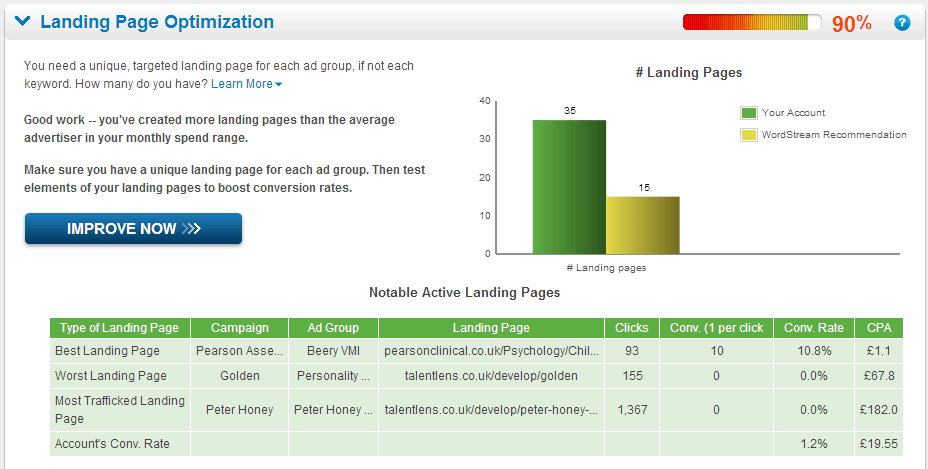
To optimise your PPC landing pages, try the following:
- Consider creating bespoke PPC landing pages that aren’t linked to your main navigation (create one for each of your top products or services)
- Set up AdWords Experiments to test two different landing pages in exact fair test conditions and see if one page converts better than another
- Ensure every landing page has a link to your Privacy Policy
- Ensure the content on your landing page is relevant
- Check and optimise landing page speed
- Ensure all content on landing pages is unique (even if you have blocked it organically from Googlebot)
- Ensure the page clearly states what your business or product or service is
- Ensure your contact information (telephone number, address and email address) is located on every landing page
- Ensure your privacy policy is linked to from every landing page
- Avoid pop-ups and too many ads
- Regularly review the bounce rate and time on page for each landing page
Settings
This section of the post goes over some of the standard settings you can find in your campaign setting tab:
Campaign Type
If you are running a standard search campaign, you should ensure your campaign is set to ‘Search Network Only’, with all features enabled.
This ensures your campaign is not opted into the Display Network, which has a naturally low CTR and would bring down the overall CTR of your campaign.
Networks
Within AdWords you can opt into Google Search Partners, which shows your ads on other websites that have search functions, such as directories.
This also includes Google Maps, so if you are a local business who would like ads to appear on Google Maps, opt into Search Partners.
In my experience, Search Partners perform differently depending on the vertical you are in, so my advice would be to test it for a couple of weeks and analyse your data to see if it converts well for you.
I have seen Search Partners produce lower CTRs in many instances, however it can also have lower CPCs which result in cheaper conversions.

Languages
Ensure your campaign is set to the language that your searchers will use. Google will then target your ads to users who are searching using this language, or have this language selected on their Google profile.
IP Exclusions
You can exclude up to 12 IP addresses per campaign.
Find your competitors IP addresses from their website (https://whois.net/) and from any emails you have from them (https://whatismyipaddress.com/trace-email).
Blocking competitors IP addresses is beneficial to reduce the likelihood of them seeing any new ad text ideas or offers in your ads, although it’s not fool proof and they may have more than one IP address.
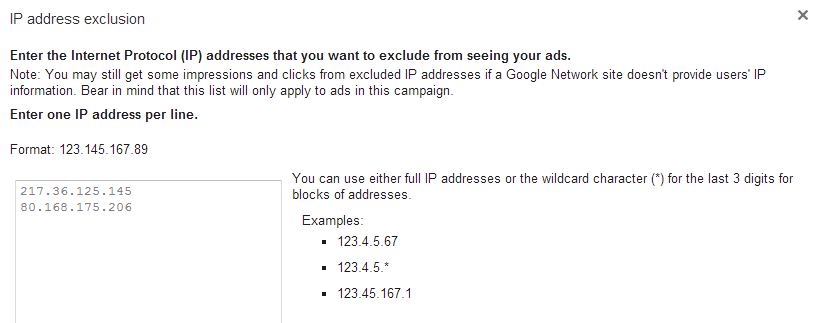
So hopefully this post has given you some ideas on what to check for during a PPC audit. if you have any other suggestions or ideas that I haven’t included please leave them in the comments section below.
Image Source
An image of a audit text message man via BigStock
Leave a Reply